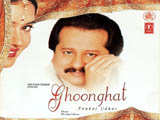Lyrics of Ghoonghat Ko Mat Khol - छम छम करके कहते हैं
 Ghoonghat (Pankaj Udhas) |
|
ye paayliya ke bol
chham chham karke khete hai
ye paayliya ke bol
chham chham karke khete hai
ye paayliya ke bol
ghoonghat ko mat khol
ke gori ghoonghat hai anmol
ghoonghat ko mat khol
ke gori ghoonghat hai anmol
chham chham karke khete hai
ye paayliya ke bol
ghoonghat ko mat khol
ke gori ghoonghat hai anmol
ghoonghat ko mat khol
ke gori ghoonghat hai anmol
sundarta ka tez anokha
isko gori chupa ke rakhna
kajre naino ki nagri
yun hi sajake rakhna
ghoonghat hi me rup ka dhan hai
nahi hai is ka mol
ghoonghat ko mat khol
ke gori ghoonghat hai anmol
chham chham karke khete hai
ye paayliya ke bol
ghoonghat ko mat khol
ke gori ghoonghat hai anmol
dulhen ke sang aaye baraati
ghunj rahe hai shehnaai
dil ke saaz pe nagme chehke
rut hai milan ki aai
ghungroo khanke paayal chhanke
baje shuhane dhol
ghoonghat ko mat khol
ke gori ghoonghat hai anmol
chham chham karke khete hai
ye paayliya ke bol
ghoonghat ko mat khol
ke gori ghoonghat hai anmol
ghoonghat hi hai tan ki maya
ghoonghat hai ek roop khazana
bheegi rain me dheere dheere
ghoonghat ko sarkana
chupke chupke dhekhte rehna
sajan ko aankhe khol
ghoonghat ko mat khol
ke gori ghoonghat hai anmol
chham chham karke khete hai
ye paayliya ke bol
chham chham karke khete hai
ye paayliya ke bol
ghoonghat ko mat khol
ke gori ghoonghat hai anmol
ghoonghat ko mat khol
ke gori ghoonghat hai anmol
The lyrics provided are from a Goonghaat Album by Pankaj Udhas, and they convey a celebratory and festive mood typically associated with weddings in Indian culture.
| Thumb | Song Heading | Singer / Movie | Music By / Lyricist | Actor / Category |
|
| Video of the song from youtube |
The song seems to focus on the beauty and significance of the bride's veil, or "Ghoonghat," in the context of a wedding ceremony. Let's break down the lyrics and explore their meanings.
Chham Chham Karke Khete Hai
The repetition of "chham chham karke khete hai" suggests a rhythmic and celebratory expression. It could be translated as "they say with joy and enthusiasm."
Ye Paayliya Ke Bol
"Ye paayliya ke bol" translates to "the anklets say" or "the anklets speak." This could refer to the sound of the bride's anklets, which is often associated with joy and celebration in wedding settings.
Ghoonghat Ko Mat Khol
"Ghoonghat ko mat khol" translates to "don't lift the veil." The veil, or ghoonghat, is a traditional element in Indian weddings that the lyrics seem to emphasize. It adds an element of mystery and anticipation.
Ke Gori Ghoonghat Hai Anmol
"Ke gori ghoonghat hai anmol" translates to "because, fair one, the veil is priceless." This line underscores the importance and value attached to the bride's veil. It symbolizes purity, modesty, and the sacredness of the marital bond.
Sundarta Ka Tez Anokha
"Tez anokha" refers to unique and intense beauty. "Sundarta ka tez anokha" translates to "the unique intensity of beauty." This line praises the exceptional beauty associated with the bride.
Isko Gori Chupa Ke Rakhna
"Isko gori chupa ke rakhna" means "keeping this fair one hidden." It suggests preserving and protecting the bride's beauty by keeping her veiled.
Kajre Naino Ki Nagri
"Kajre naino ki nagri" translates to "the city of kohl-lined eyes." This could be a poetic way of describing the bride's captivating eyes adorned with kohl.
Yun Hi Sajake Rakhna
"Yun hi sajake rakhna" means "adorn it just like this." The lyrics express the sentiment of maintaining the beauty and adornment associated with the wedding ceremony.
Ghoonghat Hi Me Rup Ka Dhan Hai
"Ghoonghat hi me rup ka dhan hai" translates to "in the veil lies the treasure of beauty." This line reinforces the idea that the ghoonghat holds immense value and beauty.
Dulhen Ke Sang Aaye Baraati
"Dulhen ke sang aaye baraati" refers to the wedding procession arriving with the bride. Baraati are the guests and relatives who accompany the groom to the wedding.
Ghunj Rahe Hai Shehnaai
"Ghunj rahe hai shehnaai" suggests the sound of the shehnai, a traditional Indian musical instrument played during weddings.
Dil Ke Saaz Pe Nagme Chehke
"Dil ke saaz pe nagme chehke" can be translated as "melodies echoing on the heart's musical instrument." This line evokes the emotional and melodious atmosphere of a wedding.
Rut Hai Milan Ki Aai
"Rut hai milan ki aai" means "the season of union has arrived." This emphasizes the joyous occasion of the union between the bride and groom.
Ghungroo Khanke Paayal Chhanke
"Ghungroo khanke paayal chhanke" refers to the sound of the ghungroo (ankle bells) and paayal (anklet), adding to the festive and musical atmosphere.
Baje Shuhane Dhol
"Baje shuhane dhol" indicates the beats of the celebratory drum (dhol) resonating in the air.
Ghoonghat Hi Hai Tan Ki Maya
"Ghoonghat hi hai tan ki maya" can be translated as "the veil is the illusion of the body." This line adds a philosophical touch, suggesting that the veil creates an enchanting illusion.
Ghoonghat Hai Ek Roop Khazana
"Ghoonghat hai ek roop khazana" means "the veil is a treasure of beauty in itself." This reiterates the theme of the ghoonghat being a valuable and beautiful aspect of the bride's attire.
Bheegi Rain Me Dheere Dheere
"Bheegi rain me dheere dheere" translates to "slowly in the wet night." This line creates a visual and romantic image, possibly referring to the post-wedding rituals.
Ghoonghat Ko Sarkana
"Ghoonghat ko sarkana" means "move aside the veil." This line may symbolize the intimacy and unveiling that occurs after the wedding ceremony.
Chupke Chupke Dekhte Rehna
"Chupke chupke dekhte rehna" suggests "keep watching quietly." It implies the beauty and charm of secretly observing the bride.
Sajan Ko Aankhe Khol
"Sajan ko aankhe khol" translates to "open the eyes to the beloved." This may signify the moment of revelation and openness in the marital relationship.
Ghoonghat Ko Mat Khol
The repetition of "ghoonghat ko mat khol" reinforces the theme of preserving the sacredness and mystery associated with the veil.
Ke Gori Ghoonghat Hai Anmol
The repetition of "ke gori ghoonghat hai anmol" reiterates the sentiment that the fair one's veil is priceless.
Conclusion
In summary, these lyrics celebrate the cultural and emotional significance of the bride's veil in the context of a wedding. The verses beautifully express the joy, beauty, and rituals associated with the union of two individuals. The repetitive refrain emphasizes the value and mystique of the ghoonghat, portraying it as an invaluable and cherished element in the tapestry of a wedding ceremony.


.png)



.png)

